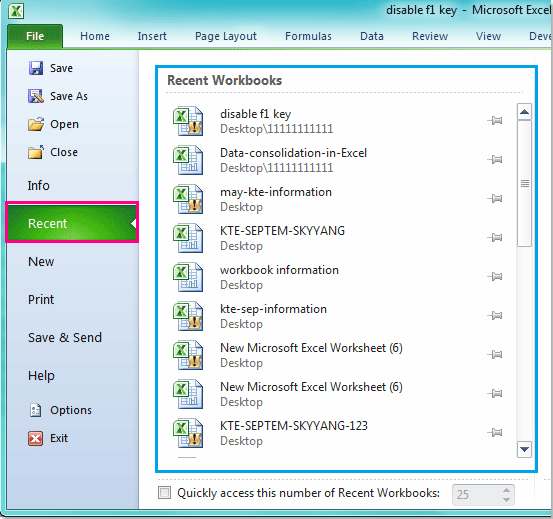Whenever you save files to a specific location on your Mac, OS X will save this location in a “Recent Places” listing which will be available the next time you save another file. This feature allows quick access to the folders you commonly use and hence saves a lot of your precious work time. Steve: Arigatou gozaimasu!!! Thanks so much for your effortless and foolproof way of emptying my Mac Word Recent files list. After retiring 3 years ago I was left with many, many dozens of old useless listings and I didn’t want to remove them all one by one (and a pox on Microsoft for that lack of foresight!!). Look what I just noticed: RECENT PLACES icon to the left of the screen. (I've seen it in Word and Excel. Can't speak for other Office apps.) Not sure what the metric is to determine what's a 'recent' place, and the list seems longer than it was in 2013. I'll see how useful it is as I acclimate to 2016. To remove the recent document lists in Excel, you can go to the Excel Options to do a little setting. Please do as follows: 1. Open a workbook, and go to click File Options (In Excel 2007. Click Office button Excel Options), and in the Excel Options dialog box, please click Advanced from the left pane, and then scroll down to the Display section and change the number to 0 besides the Show.
Every so often – usually around the time of a major new macOS release – I perform a clean install of the OS on my Macs. Along with restoring user data I tend to restore the configuration data of certain applications including the Microsoft Office applications. While this is a great timesaver, it can also cause some unexpected results. For example, the Recent file lists in Excel, PowerPoint and Word. Let’s use Word as an example.
Opening a freshly installed copy of Word, I’m greeted with the Recent file list showing all the files I opened prior to performing a clean macOS install.
Remove Recent Documents List Word 2016 For Macbook Pro
This is not as useful as it first seems. If I try to open one of these files I get a message saying that Word is unable to open that file even though I know it has been restored to the exact same location on my Mac’s drive. I assume this is because each entry is now merely a broken reference or symbolic link to the original file.
I’m left with a completely useless Recent file list. No worries, I can select all the recent file entries with a couple of mouse clicks and delete them en masse, right? Wrong. I can only select each entry individually and control-clicking gives the following options:
Not wanting to have to remove each entry separately, I started digging around the file system and found the file com.microsoft.Word.securebookmarks.plist buried deep within the Word configuration data containing all the recently opened Word documents. The full path to the file is ~/Library/Containers/com.microsoft.Word/Data/Library/Preferences/.

Rather than delete this file, I first closed Word then renamed it as com.microsoft.Word.securebookmarks.old.plist from the command line:

On re-opening Word, the Recent file list is now empty:
There are similar configuration files for Excel and PowerPoint:
Microsoft Word Mac Clear Recent Documents
This is certainly not a subtle approach. By renaming the configuration files, you’ll lose all the Recent file entries along with the Pinned and Shared With Me file lists. To me, this is preferable to having a long list of files that can’t be opened. It may also be useful if – for whatever reason – you want to start afresh with a new Recent file list.
NOTE: If you’re navigating to these files through the Finder you may not be able to locate the directories com.microsoft.Excel, com.microsoft.Powerpoint and com.microsoft.Word in the ~/Library/Containers directory. They are there, but may be displayed as Microsoft Excel, Microsoft PowerPoint and Microsoft Word respectively. This does not affect the Terminal commands shown above.
Office 2013/2016 stores your most recently used files and displays them in a list that you’ll see when you open your program (if you haven’t disabled or removed the start screen) or when you select Open from the File tab.
The Recent list can be useful if you’re opening and closing the same files repeatedly, or your file is located in a complicated location. But the list can cease to be useful if you see a lot of files that you no longer need to access, or if you’re sharing your PC and want a little more privacy. If this is the case, it’s easy to clear and disable the list.
Follow the steps in the video above, or:
- From the File tab, click Options.
- Select Advanced.
- In the Display section, change the value of Show this number of Recent Documents/Workbooks/Presentations to 0.
- Click OK.
